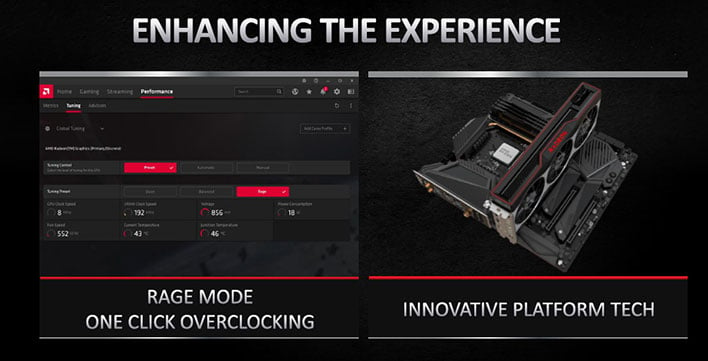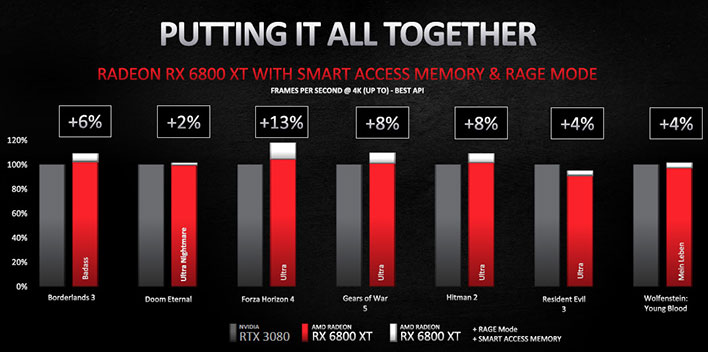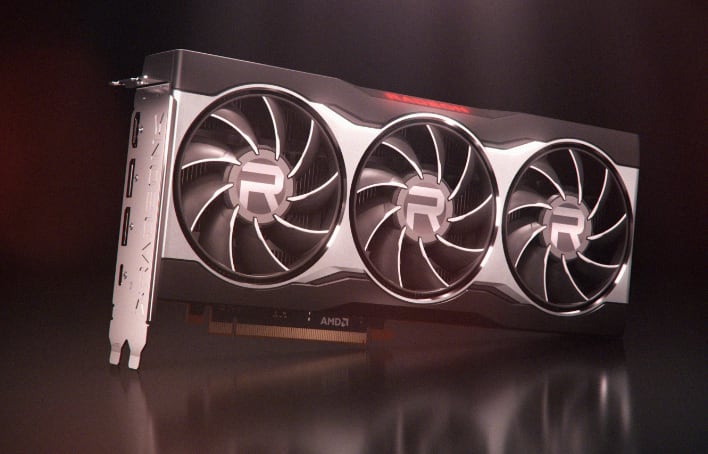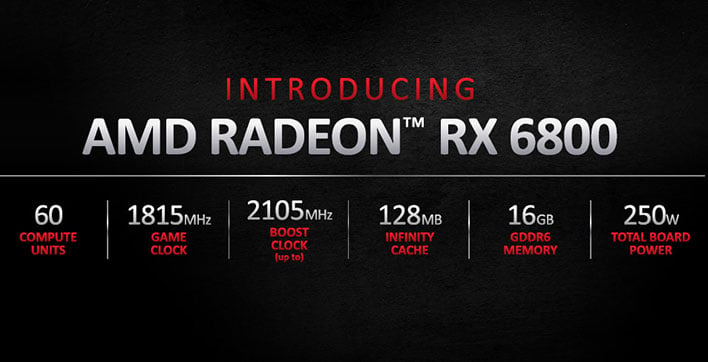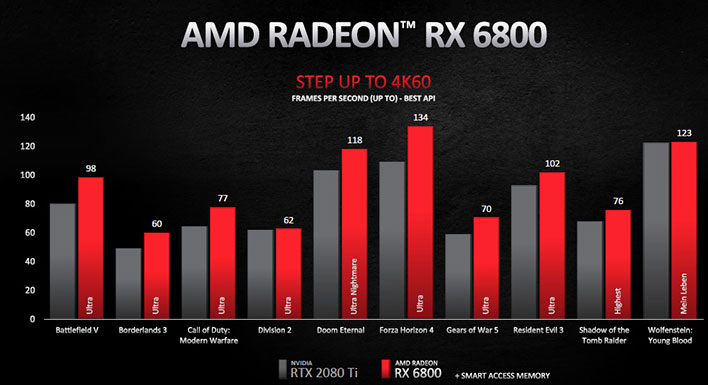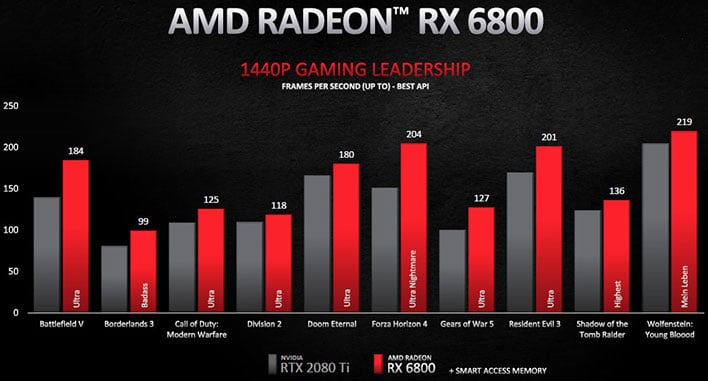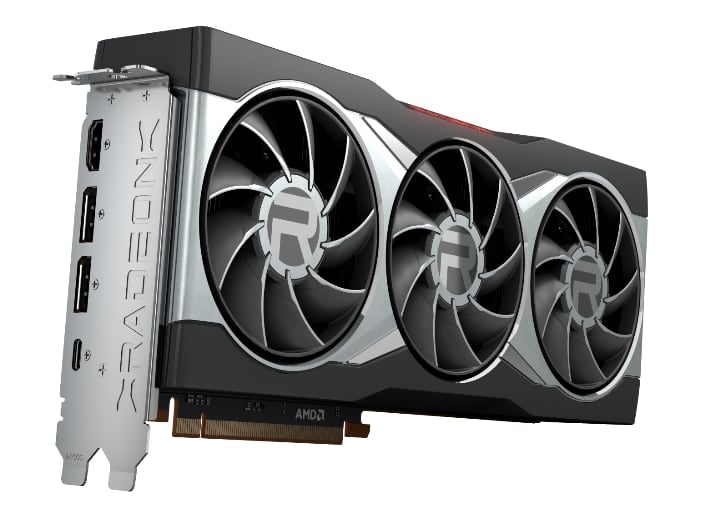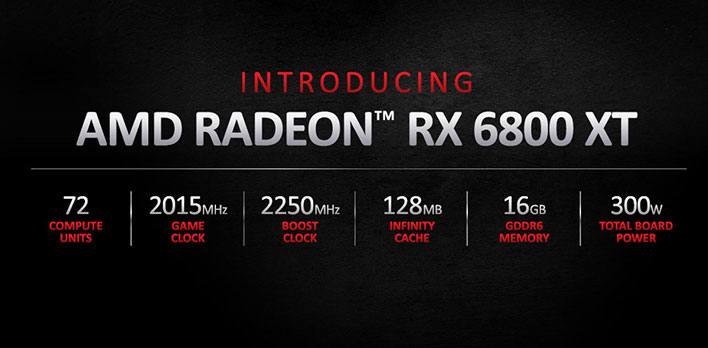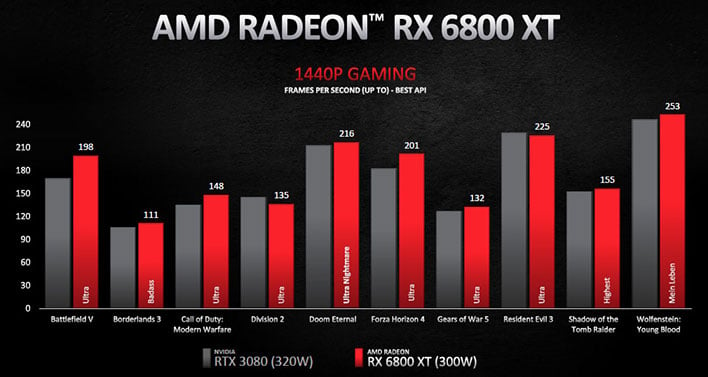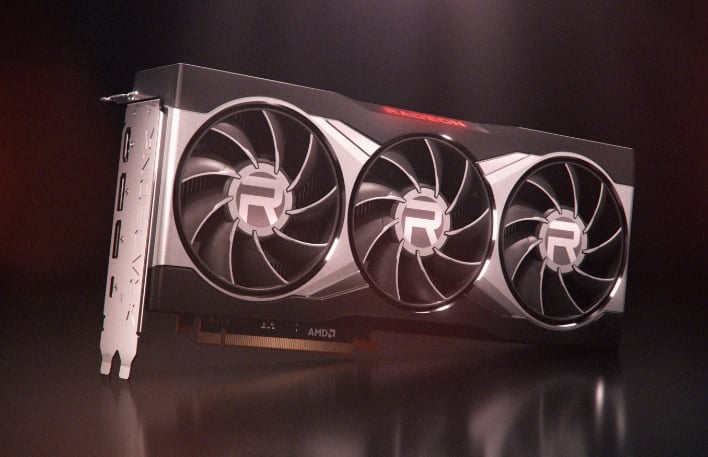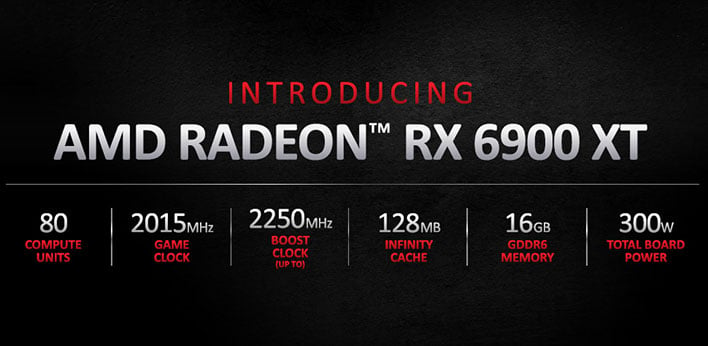AMD Unveils Three Powerful Radeon RX 6000 Series Big Navi Cards To Topple NVIDIA's Best
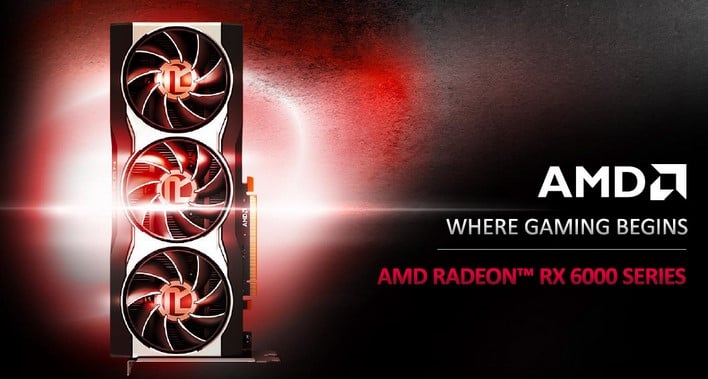
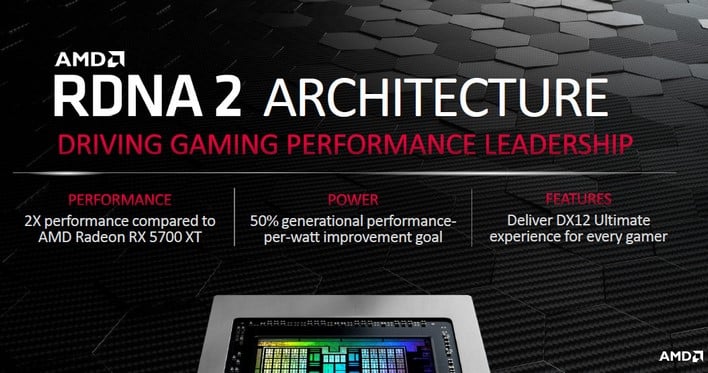
AMD RDNA 2: More Efficient With Much Higher Clocks
The Radeon RX 6000 series (and the GPUs powering the upcoming Xbox Series S/X and PS5 consoles from Microsoft and Sony) are built around AMD’s RDNA 2 architecture. As Dr. Su explained during today’s event, the goal with RDNA 2 was to help drive performance leadership in the GPU market and propel AMD back into a competitive position at the high-end of gaming. How will RDNA 2 do that? Well, RDNA 2’s compute units will reportedly offer double the performance (or more) of the CUs in the Radeon RX 5700 XT, with an approximate 50% performance-per-watt improvement. We're also looking at a leading-edge feature set that includes support for DirectX 12 Ultimate and all that comes with it, including Variable Rate Shading, Mesh Shaders, Sampler Feedback, and ray tracing. AMD noted that every RDNA 2 CU actually has integrated ray tracing accelerators that offer 10X better intersection performance than software-only, non-accelerated implementations but beyond that, no additional details were given. Microsoft’s DirectStorage API for faster game loading direct from SSD to GPU memory will be supported as well.
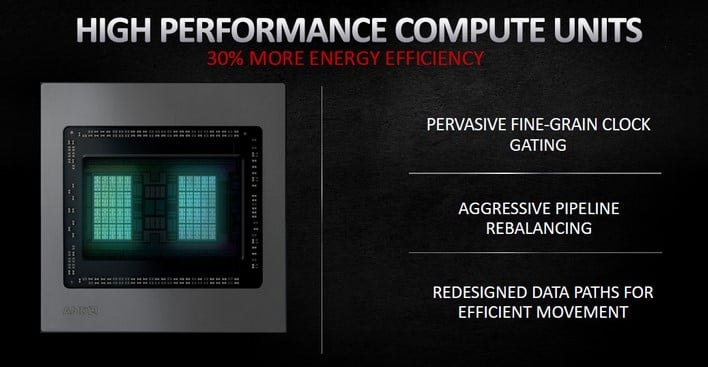
AMD achieved its goals by rebalancing the graphics pipeline and plumbing it with redesigned, high-bandwidth, more energy efficient data paths, and incorporating fine-grain clock gating throughout. Details were scarce during the event, but it was also disclosed that RDNA 2 will feature a large, 128MB pool of fast cache memory, dubbed “Infinity Cache”. According to AMD, when leveraging Infinity Cache alongside a 256-bit GDDR6 memory interface, bandwidth delivered to the GPU is more than doubled. The Infinity Cache ultimately improves absolute performance and bandwidth per watt, because it can feed data to the graphics pipeline at lower latency and with a much higher cache hit rate, which further enhances overall efficiency.
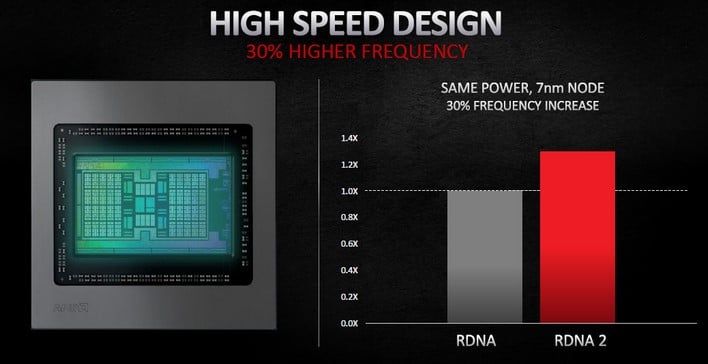
Combine the benefits of the new architecture, with Infinity Cache, and AMD’s use of optimized libraries for the 7nm process node used to build Big Navi, and the Compute Units in this first wave of RDNA 2-based GPUs end up being approximately 30% more energy efficient than previous-gen offerings. The new architecture and tuned process, however, have also allowed AMD to boost frequencies by about 30% as well. The net effect is a 54% - 65% uplift in performance-per-watt, depending on the particular model GPU tested and about 2X greater performance versus the previous-gen.
AMD Smart Access Memory And Rage Mode Unleashed
A couple of additional new features coming with the Radeon RX 6000 series include something called “AMD Smart Access Memory” and “Rage Mode”. AMD Smart Access Memory, or ASAM, allows AMD Ryzen 5000 series processors to access the entire pool of memory attached to a Radeon RX 6000 series GPU over its PCIe 4 interface.
Processors have always had the ability to peek into some portion of GPU memory (a legacy limitation of only 256MB), but Smart Access Memory grants Ryzen 5000 processors full access, which can improve performance with some workloads.

Rage Mode is a branding that AMD is giving to a new one-click overclocking mode that’ll be available in its Radeon graphics drivers. How Rage Mode differs from current one-click overclocking tools available in AMD’s drivers wasn’t exactly clear, but it apparently increases a card’s power limit, and probably simultaneously under-volts the GPU, while finding the optimal memory frequency of a particular card as well. We’ll know more soon as we get cards in for testing.
AMD showed the combined benefits of Smart Access Memory and Rage mode boosting the performance of a Radeon RX 6800 XT across and array of games by 2% - 13%. We should also mention that AMD is working on a new super-sampling and scaling mode to enhance performance when ray tracing is enabled in future titles, somewhat akin to NVIDIA’s DLSS, but it is still in the early stages of development at this point.
Radeon RX 6800 – Claimed To Best GeForce RTX 2080 Ti And GeForce RTX 3070 At $579
Three AMD Radeon RX 6000 Series GPUs were then finally unveiled, all of which reside at the high-end of the GPU market. First up, is the Radeon RX 6800. The Radeon RX 6800 will feature 60 CUs, with 128MB of Infinity Cache, along with Game and Boost clocks of 1,815MHz and 2,105MHz, respectively. 16MB of GDDR6 is attached to the GPU and the card will have a total board power of 250 watts.
AMD positioned the Radeon RX 6800 alongside the GeForce RTX 2080 Ti and showed the new Radeon outpacing the expensive previous-gen GeForce card across the board in a variety of games at 1440P and 4K. If you take these numbers at face value, this would mean the Radeon RX 6800 is also faster than the just-launched GeForce RTX 3070 as well. With the RTX 3070 priced at $499, AMD is commanding a premium here at its $579 entry price, but also delivering better performance in return, across the board, (and a larger 16GB GDDR6 frame buffer) as you can see in the AMD-provided performance graphs above.
Radeon RX 6800 XT – A Fierce GeForce RTX 3080 Competitor At $649
Moving up the stack, we have the Radeon RX 6800 XT. AMD’s Radeon RX 6800 XT also has 128MB of Infinity cache and 16GB of GDDR6 memory, but the CU count is increased to 72. This GPU’s Game clock is also much higher at 2,015MHz and the Boost clock a lofty 2,250MHz, as well. The additional CUs and higher clocks push the board power up into 300W territory, but also result in a nice performance uplift.
The Radeon RX 6800 XT was apparently the card Dr. Su teased earlier this month, as today’s event showed it trading blows with NVIDIA’s GeForce RTX 3080 at 1440P and 4K. At its $649 entry price, this AMD Radeon RX 6000 family member bests its closest NVIDIA competitor by about $50. With an extra 6GB of GDDR6 memory on board, the Radeon RX 6800 XT is a solid value proposition.
Radeon RX 6900 XT Takes On GeForce RTX 3090 In The Trenches At $999
As some suspected, the Radeon RX 6800 XT wasn’t the best GPU AMD had lying in wait. The Radeon RX 6900 XT was also revealed today, with a similar frequencies, power, cache and memory configurations to the RX 6800 XT, but with more CUs – 80 in total to be exact.
With those additional CUs – and AMD Smart Access Memory and Rage Mode enabled – the Radeon RX 6900 XT seems to compete favorably with NVIDIA’s current top-end GeForce RTX 3090. Without ASAM and Rage Mode, the scales likely tip towards NVIDIA somewhat, but AMD is still apparently keeping some things close to the vest. Regardless, simply having a card in the line-up that competes in this space is a huge win for AMD. It's also potentially a huge win for enthusiast gamers at its $999 price point, which is several hundreds less than a $1499 GeForce RTX 3090.
We should also note that all of these Radeon RX 6000 series cards have the same 2.5 slot, triple-axial coolers with 10.5” form factors, and they use standard PCIe power connectors. So plunking one into any current PC shouldn’t require anything out of the ordinary, unlike NVIDIA’s GeForce RTX 3090 monster card.
Availability, Radeon Wrap-Up And The Road Ahead

The Radeon RX 6800 and RX 6800 XT are due to arrive on November 18. AMD’s flagship Radeon RX 6900 XT, however, will arrive a little later on December 8.
Things are looking promising for AMD and its new Radeon RX 6000 series. Today’s revelations position the cards directly at the high-end of the GPU market versus NVIDIA, and AMD’s direct connection with Microsoft’s and Sony’s consoles, which leverage the same GPU architecture, should facilitate robust feature support and optimization efforts with game developers as well.
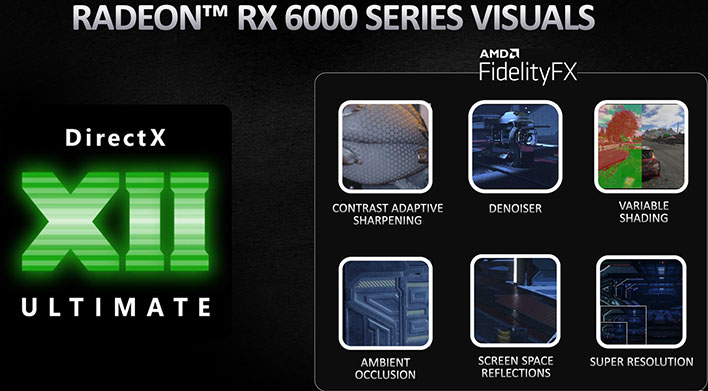
In discussions with AMD, the company was quick to point out its intention of fostering open, non-proprietary technologies in its FidelityFX image quality toolkit for in-game effects like Adaptive Sharpening, Variable Rate Shading and Super Resolution. It will be interesting to watch how AMD’s huge influence in the console gaming ecosystem could have an affect on PC gaming adoption of the company’s technologies.
Stay tuned in the weeks ahead, as we get AMD’s Radeon RX 6000 family in for a spin around the test track. The competitive graphics card landscape just kicked into another gear.

